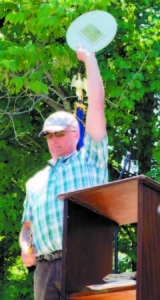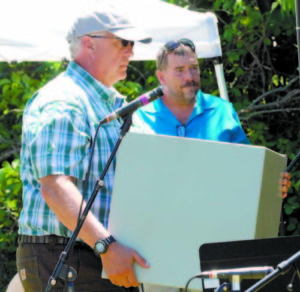Bridgton 250: My dad left me challenging puzzle to solve — Frank Howell
July 3, 2018
My Dad, C.F. “Pete†Howell, had a mischievous sense of humor. As a self-taught engineer, Pete’s love for the creative found various ways to manifest…and, reach across the decades.
Several months ago, I was contacted by Mike Davis of the Bridgton Historical Society and asked to take a look at Bridgton’s Bicentennial time capsule. Planning for Bridgton’s 250th celebration was well underway and anticipation was building as the date to open the time capsule approached. Wouldn’t it be great to open it at a ceremony and have a new time capsule to seal? He explained that they understood that Pete designed it and his fabrication team at Howell Labs built it. The twist here is that they had no idea how to open it.
As I thought about it, memories of my Dad talking about the time capsule bubbled up; apparently, my eight-year-old brain was engaging again. I didn’t remember the details, but I did remember his grin as he plotted. I had to see this thing.
 Mike delivered an 18-inch cube, painted U.S. Navy gray, with two curious crooked pipes sticking out of one side. On another side, an engraved plate announces the particulars. The edges were beautifully welded, the metal plates smooth with no seams to hint at a clever mechanism to win entry. Dad’s mischievous grin was suddenly making sense.
Mike delivered an 18-inch cube, painted U.S. Navy gray, with two curious crooked pipes sticking out of one side. On another side, an engraved plate announces the particulars. The edges were beautifully welded, the metal plates smooth with no seams to hint at a clever mechanism to win entry. Dad’s mischievous grin was suddenly making sense.
Like my Dad, I fell in love with creative engineering a bit later in my career. Life’s eddies and currents brought me back to Bridgton after years away working for the military. During the last years of his life, the two of us teamed up and tackled various engineering problems vexing the military. We grew close during those days as he taught me how to think “outside-the-box†and his enthusiasm for inventive thought inspired me.
Twenty years after his passing, the time capsule landed in my lap. Somewhere in the cosmos, Dad grinned…the joke, after all, was on me.
As I inspected “The Artifact,†the engineering challenges became apparent: the pipes were needed to bathe the interior with inert gas so that the contents would not be incinerated when the cover was welded in place. The inert gas also provided the perfect environment to preserve the contents over the decades. The engraved plate was welded, not riveted, to the exterior to maintain the vessel’s integrity. He also positioned the plate off of The Artifact’s surface to minimize the liability of galvanic corrosion.
I accepted Dad’s challenge and tried to do him one better, as sons are inclined to do. Rather than design a new time capsule, it made more sense to me to devise a way to open The Artifact without damaging it and also allow it to be reused for Bridgton’s 300th year celebration.
Like my Dad, I’ll pass on the joke to the next generation.


